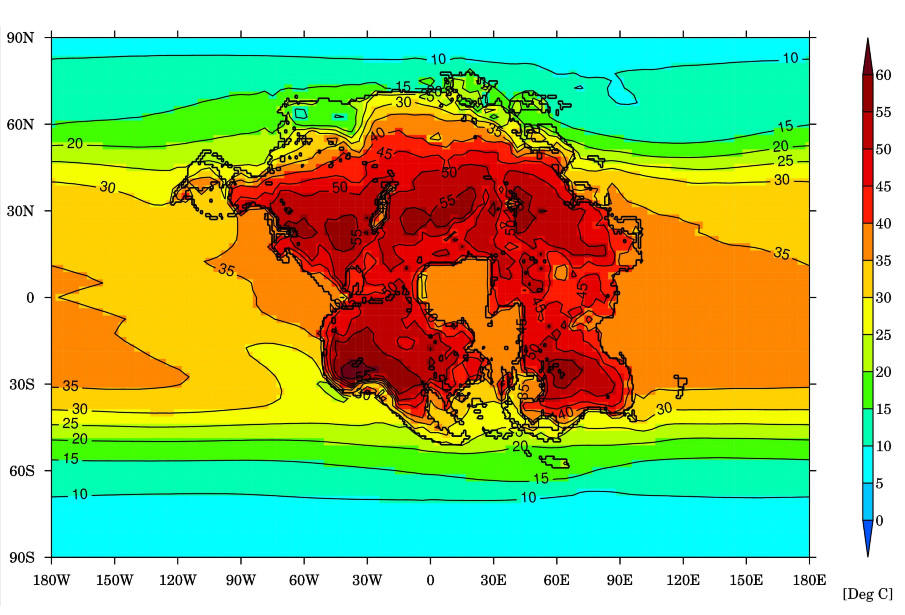
29th September 2023 Supercontinent predicted to make Earth uninhabitable in 250m years A study on Pangaea Ultima finds that the hypothetical supercontinent will make Earth uninhabitable for most forms of life in 250 million years, due to extreme temperatures.
Temperature map of Earth, 250 million years in the future. Credit: University of Bristol
Unless humanity finds a way to prevent it, the Sun will expand to engulf what remains of Earth and the inner planets by 5 billion AD. Long before that, however, conditions on our planet are likely to become hostile. The Sun's increasing luminosity will cause Earth's average temperature to reach a sweltering 47°C (116°F) by the year 1 billion AD. Now, a new study finds that extreme heat will pose an existential threat much sooner. The period in question – around 250 million years from now – is still unimaginably far in the future, but significantly cuts the remaining time available for higher life such as mammals, birds, fish, reptiles, and other species. The research, published this week in Nature Geoscience, presents the first-ever supercomputer climate simulations of the distant future and demonstrates how climate extremes will dramatically intensify when the world's continents merge to form one hot, dry, and largely uninhabitable supercontinent. In addition to a larger and brighter Sun, tectonic processes occurring in the Earth's crust will result in more frequent volcanic eruptions, the study projects, triggering huge releases of carbon dioxide that further warm the planet.
Mammals, including humans, have survived historically thanks to their ability to adjust to weather extremes, especially through adaptations such as fur and hibernating in the cold, as well as short spells of warm weather hibernation. But while mammals have evolved to lower their cold temperature survivable limit, their upper temperature tolerance has generally remained constant. This makes exposure to prolonged excessive heat much more difficult to overcome and the climate simulations, if realised, would ultimately prove unsurvivable. "The newly-emerged supercontinent would effectively create a triple whammy, comprising the continentality effect, hotter Sun, and more CO2 in the atmosphere, of increasing heat for much of the planet," explains Dr Alexander Farnsworth, Senior Research Associate at the University of Bristol, and the study's lead author. "The result is a mostly hostile environment, devoid of food and water sources for mammals," Farnsworth continues. "Widespread temperatures of between 40 and 50 degrees Celsius, and even greater daily extremes, compounded by high levels of humidity would ultimately seal our fate. Humans and many other species would expire due to their inability to shed this heat through sweat cooling their bodies." His team applied climate models, simulating temperature, wind, rain, and humidity for Pangea Ultima, the name for this next supercontinent. To estimate the future level of CO2, they used models of tectonic plate movement, ocean chemistry, and biology to map the inputs and outputs of gases. Only somewhere between 8% and 16% of land would be habitable for mammals when the supercontinent forms, the findings indicate. Some areas in the northern and southern peripheries might be survivable, according to Farnsworth. "The outlook in the distant future appears very bleak," says Farnsworth. "Carbon dioxide could be double current levels. The Sun is also anticipated to emit about 2.5% more radiation and the supercontinent will be located primarily in the hot, humid tropics." With 40 to 50 degrees Celsius being common in this future world, extreme "outlier" temperatures of 70 degrees or more would occur in some regions at certain times of the year, the study found. For comparison, the current record high for a surface measurement is 56.7°C (134.1°F), at Death Valley in the United States on 10th July 1913. At that sort of temperature, even most bacteria and viruses are inactivated, according to the World Health Organization. For added perspective: a glass of water might take two weeks to evaporate at room temperature. But at 70°C, its water could vanish in just a few hours. "This work also highlights that a world within the so-called 'habitable zone' of a solar system may not be the most hospitable for humans, depending on whether the continents are dispersed, as we have today, or in one large supercontinent," adds Farnsworth.
Comments »
If you enjoyed this article, please consider sharing it:
|








